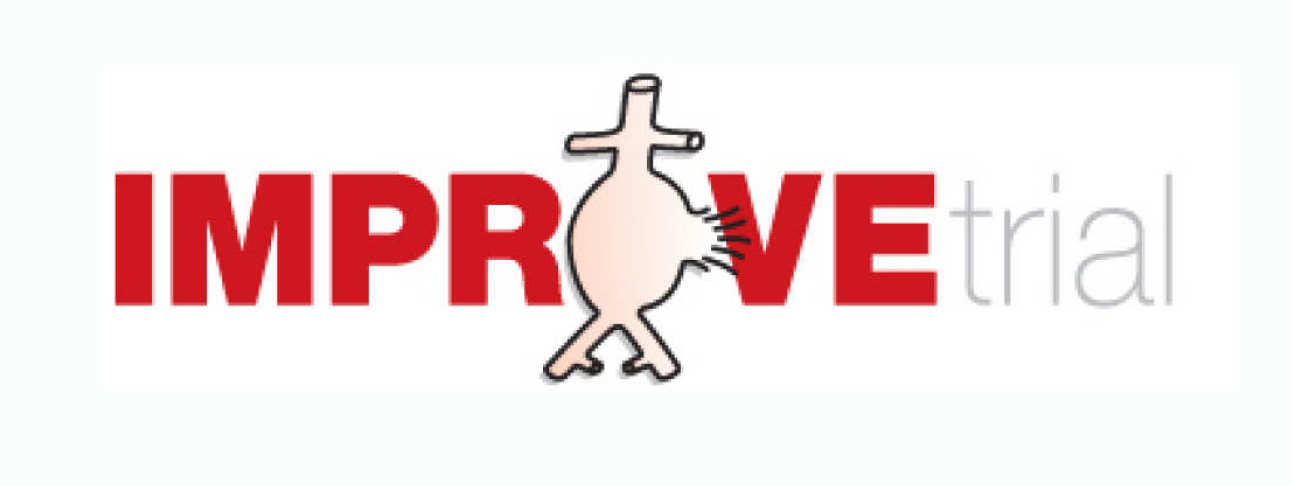Trial co-ordinating centre staff
Chief Investigator:
Prof Janet Powell
(j.powell@imperial.ac.uk)
Prof Roger M. Greenhalgh
(r.greenhalgh@imperial.ac.uk)
Trial Manager:
Dr Pinar Ulug
(improvetrial@imperial.ac.uk)

IMPROVETrial_vFinal
Aim
To compare the mortality from ruptured abdominal aortic aneurysm (AAA) in patients treated by an endovascular first strategy versus the conventional treatment of immediate open repair.
Design
Multi-centre randomised controlled trial, ISRCTN 48334791
Setting
Specialist vascular centres credentialed for emergency endovascular AAA repair
Methods
Initial management of patients with suspected ruptured AAA with a fluid restriction protocol. When the in-hospital clinical diagnosis of ruptured AAA has been established, patients will be randomised to either an endovascular first strategy or to immediate open surgical repair. Patients randomised to an endovascular first strategy will be sent for immediate CT scan to determine their anatomical suitability for endovascular repair (approximately 60% patients will be suitable). Suitable patients will then undergo immediate endovascular repair and the remainder open repair.
Outcome measures
The primary outcome is 30-day mortality. Secondary outcome measures include 24h, in-hospital and 1-year and 3-year mortality, complications and morbidities associated with the two treatment strategies as well as quality of life, costs and cost-effectiveness.
Size of the trial
The trial plans to recruit 600 patients over a 27 month period, to provide 90% power to detect (as significant at 5%) a difference in 30-day mortality of 14%, with mortality estimated at 44.6% in the open repair group and 30.4% in the EVAR first strategy group.
Funders
National Institute for Health Research (NIHR) Health Technology Assesment Programme (project number 07/37/64).
Eligibility
The trial will include all non-moribund patients with a clinical diagnosis of ruptured AAA made in hospital, including patients transferred from other hospitals with a diagnostic CT scan.
Exclusions
- Patients with known connective tissue disorders (e.g. Marfan syndrome) where endovascular repair may not be beneficial.
- Patient with known previous repair of an abdominal aortic aneurysm, because procedures either open or endovascular are likely to be very complex and there are no guidelines for anatomical restriction to repair.
- Deeply unconscious or moribund patients, with minimal chance of recovery.
(Exclusions will be documented)
Procedure & follow-up (active for 3 years)
- Procedure is determined by randomisation; half the patients require immediate CT scan to determine suitability for EVAR. (CT scans will be assessed in a core laboratory)
- Each centre has a free choice of endografts & technical approach to the aorta; CT is optional for the open repair group
- Following aneurysm repair, please notify the patient’s general practitioner and, in UK complete ONS flagging card, which includes the patient's NHS number
- Patients who have been discharged following operation will be required to attend outpatients according to local clinical protocols.
- At 3 and 12 months post-operation the patient will be asked to attend an outpatients appointment to obtain the following information:
- EuroQol form completed (3 months, 12 months and 3 years during clinic visit or by post)
- CT scan for Patients with endovascular repair (3 months only)·
- “Health Resources” questionnaire for the patient to complete at home (3 and 12 months), for UK patients·
- Re-interventions and major morbidities (MI, stroke, renal replacement therapy, amputation) will be recorded to 3 years. Deaths to 5 years
- When you gave consent for the trial, you had agreed for the trial team to obtain further information about your health status from NHS Information Centre and NHS Central Register. There have been a number of organisational changes and both bodies are now included in NHS digital. We use information from NHS Digital to cross-check the number of additional procedures you may have undergone following your emergency aneurysm repair, so that we have accurate information about re-interventions even if you have moved or are treated at a different hospital.
- Frequently Asked Questions for patients participating in the trial (pdf)
Outcomes
Interim 3 year results were presented on 1st December 2016 at the Vascular Societies’ ASM in Manchester, followed by publication of the final results in November 2017.
3-year outcomes paper
You can read the three-year paper as published in the British Medical Journal on 14th November 2017, available at https://doi.org/10.1136/bmj.j4859
You can read the one-year paper as published in the European Heart Journal online edition in April 2015. For supplementary material see our One year outcomes (pdf).
30-day outcomes paper
- 30-day results was published in the British Medical Journal online edition on 13th January 2014.
- BMJ pico (abridged) format was published in the print edition on 8th February 2014.
- Patients who participated in the trial can also read Key findings from the trial.
